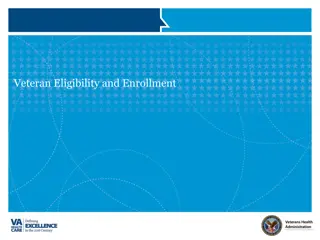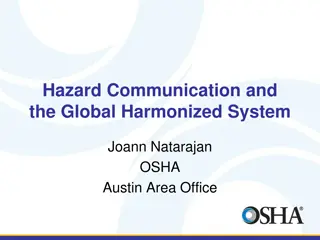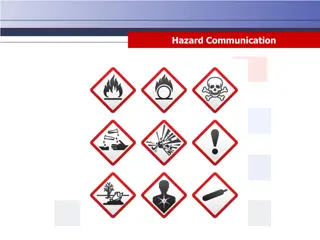Hazard Mitigation Assistance (HMA) Funding Eligibility and Priority
Entities within the declared disaster area have priority to apply for Hazard Mitigation Assistance (HMA) funding. Eligible applicants include those in Clackamas, Coos, Douglas, Jackson, Jefferson, Josephine, Klamath, Lake, Lane, Lincoln, Linn, Marion, Tillamook, Wasco, Washington, Yamhill Counties, and others directly affected by Oregon wildfires and straight-line winds. The funding covers pre-disaster resilience programs like BRIC and post-disaster grants like HMGP and HMGP-PF.
Download Presentation

Please find below an Image/Link to download the presentation.
The content on the website is provided AS IS for your information and personal use only. It may not be sold, licensed, or shared on other websites without obtaining consent from the author. Download presentation by click this link. If you encounter any issues during the download, it is possible that the publisher has removed the file from their server.
E N D
Presentation Transcript
Hazard Mitigation Assistance (HMA) Oregon State Hazard Mitigation Officer (SHMO) Amie Bashant (on leave until April) 503-378-4660 shmo@mil.state.or.us Deputy State Hazard Mitigation Officer (DSHMO) Anna Feigum 503-798-7240 shmo@mil.state.or.us
8/4/2024 2
HMA Grant Programs Pre-Disaster: building resilient infrastructure and communities (BRIC) *Formerly, pre-disaster mitigation (PDM) flood mitigation assistance (FMA); and Post-Disaster: hazard mitigation grant program (HMGP); hazard mitigation grant program post fire (HMGP-PF) 8/4/2024 3
Current Open Post-Disaster Rounds HMGP-DR-4562-OR Tied to the 15 September 2020 Disaster Declaration HMGP-PF-FM-5327-OR Tied to the 16 FMAGs 8/4/2024 4
HMGP-PF-FM-5327-OR HMGP-DR-4562-OR Directly Affected Areas Clackamas, Coos, Douglas, Jackson, Jefferson, Josephine, Klamath, Lake, Lane, Lincoln, Linn, Marion, Tillamook, Wasco, Washington, and Yamhill Counties in addition to Warm Springs Indian Reservation Benton, Clackamas, Columbia, Coos, Deschutes, Douglas, Jackson, Jefferson, Josephine, Klamath, Lake, Lane, Lincoln, Linn, Marion, Multnomah, Tillamook, Wasco, Washington, and Yamhill Counties in addition to any Tribal lands that were directly affected Incident Type - Oregon Wildfires And Straight-line Winds Declaration Date August 13, 2020 (first FMAG declaration) September 15, 2020 SHMO sent out initial statewide guidance September 25, 2020 October 24, 2020 Pre-application due to SHMO January 15, 2021 April 15, 2021 April 1, 2021 July 1, 2021 Subapplication due to SHMO February 19, 2021 May 28, 2021 August 25, 2021 November 29, 2021 Subapplication due to FEMA from SHMO March 30, 2021 June 28, 2021 September 15, 2021 December 14, 2021 Period of Performance March 30, 2024 June 28, 2024 September 15, 2024 December 14, 2024 Federal Funds $10,074,896.00 $60,045,205.00 (per 30-day estimate) Federal Funds Still Available as of 1/6/2021 $6,390,453.50 $42,917,288.40 8/4/2024 5
Who is eligible to apply for HMA funding? Who is eligible to apply for HMA funding? Priority of Funds Priority of Funds Those entities within the HMGP grant declared disaster area will take priority during the application process, however all entities interested in funding are encouraged to apply. Natural Hazard Mitigation Plan Requirement (PNPs exempt) Natural Hazard Mitigation Plan Requirement (PNPs exempt) To be an eligible subapplicant, entities must have a FEMA-approved National Hazard Mitigation Plan (NHMP) or be annexed into one at the time of HMGP award. However, an Extraordinary Circumstances Exception (ECE) can be submitted at the time of award for a one-year extension. If your entity is interested in applying for HMGP funding but does not have a current FEMA-approved NHMP, please contact the SHMO to discuss possible options. 8/4/2024 6
Life of an HMA subapplication: Applying for Funds Pre- Subapplication Period Opens Review Panel* application/Letter of Intent State Approval and Submittal to FEMA Revise Subapplication Subapplication
Post-disaster Overview State (the SHMO) is considered the applicant and local entities, state agencies, special districts, etc. are considered subapplicants Private nonprofits (PNPs) are eligible to apply Tribes may be the applicant or subapplicant (varies for each disaster) State (the SHMO) creates and sends out the NOFO once the 30-day estimate is received for HMGP State (the SHMO) creates and sends out the NOFO within 2-3 weeks of the first FMAG declaration for HMGP-PF (timeline may vary depending on number of FMAGs, etc.) Once subapplications are submitted to FEMA, the pre-award process takes 10-18 months for award The Period of Performance (POP) for HMGP begins with the opening of the application period and ends no later than 36 months from the close of the application period (subject to change) Uses a different platform than pre-disaster applications (HMGP subapplications are a Word document and SHMO data enters information into NEMIS) Benefit-cost-analysis (BCA) is typically the biggest challenge for subapplicants 75/25 cost share (75% comes from federal and 25% comes from local) 8/4/2024 8
4562 Federal Funds As of 3.4.2021, approximately $28.9 million remains in federal funds for 4562 Projects do not need to be tied to the disaster for 4562, nor to impacted areas. You can undertake mitigation projects for any type of hazard, in any at-risk area. 8/4/2024 9
5327 Federal Funds As of 3.4.2021, approximately $789,000 remains in federal funds for 5327. Projects do not need to be tied to the disaster for 5327, nor to impacted areas. You can undertake mitigation projects for any type hazard, in any at-risk area. 8/4/2024 10
HGMP Categories HMGP grants have 4 different categories that can be applied for (only one of the four per pre-application and subapplication): 1) Projects: There are a variety of eligible projects. 2) Plans: Natural Hazard Mitigation Plans (NHMP) and Community Wildfire Protection Plans (CWPP) are the two most common uses for planning funds. Emergency Operations Plans are ineligible. 3) 5% Initiative: For mitigation activities that are difficult to evaluate using FEMA-approved cost-effectiveness methodologies. 4) Advance Assistance: Used to develop mitigation strategies and obtain data to prioritize, select, and develop complete HMGP applications in a timely manner (up to 25% of the HMGP ceiling or up to $10,000,000). 8/4/2024 11
Protecting Manufactured Homes from Floods and Other Hazards https://www.fema.gov/sites/default/files/2020- 08/fema_p85.pdf FEMA Hazard Mitigation Ideas: https://www.fema.gov/sites/default/fil es/2020-06/fema-mitigation-ideas_02- 13-2013.pdf 8/4/2024 12
Types of Eligible Fire-related Projects Defensible space measures The creation of perimeters around residential and nonresidential buildings and structures through the removal or reduction of flammable vegetation Ignition-resistant construction The application of non-combustible building envelope assemblies, the use of ignition-resistant materials, and the use of proper retrofit techniques in new and existing structures (must also include defensible space in order to be eligible for this type of project) Hazardous fuels reduction Vegetation management to reduce hazardous fuels, vegetation thinning, and the reduction of flammable materials to protect life and property beyond defensible space perimeters but proximate to at-risk structures Infrastructure Retrofit Measures to reduce risk to existing utility systems, roads, and bridges. 8/4/2024 13
Ineligible Fire-related Projects Projects that do not protect homes, neighborhoods, structures, or infrastructure Projects on federally owned land and land adjacent to Federal lands when the proposed project falls under the primary or specific authority of another Federal agency Projects for hazardous fuels reduction in excess of 2 miles from structures Projects to address ecological or agricultural issues related to land and forest management (e.g., insects, diseases, infestations, damage from extreme weather events affecting the forest-wide health) Irrigation of vegetation to avoid disease or drought-related infestation Projects to protect the environment or watersheds Projects for prescribed burning or clear-cutting activities Projects for maintenance activities, deferred or future, without an increase in the level of protection Projects for the purchase of fire-related equipment (e.g., vehicles, fire trucks) or communications equipment Projects for the creation and maintenance of fire breaks, access roads, and staging areas Purchase of equipment to accomplish eligible work (e.g., chainsaws, chippers) Projects for vegetation irrigation systems installed on the ground and designed to moisten the surface Development or enhancement of fire-suppression capability through the purchase of equipment or resources (e.g., water supply or sources, dry hydrants, cisterns not related to water hydration systems, dip ponds) Activities intended solely to remedy a code violation without an increase in the level of protection Activities on Federal land 8/4/2024 14
Flooding-related Project Examples Property Acquisition and Structure Demolition Property Acquisition and Relocation for Open Space Structure Elevation For burn scar remediation and reseeding it is only effective if we can get it awarded and completed very quickly. Flash floods are a huge problem in burn scar areas and we have a hard time being effective with these grants. Basically, the subapplicant should use aerial seeding methods for low ground disturbance and if they are going to use chemicals for invasive plant species, make sure that information, including type of herbicide, is in the subapplication. There are several other eligible projects as well; see HMA Guidance and the HMA Addendum for further information and options. 8/4/2024 15
Soil Stabilization (flood after fire) Soil stabilization projects are eligible under HMGP, HMGP Post Fire, and PDM. Wildfires can destroy vegetation, root systems, and degrade soil quality, which can increase soil and slope erosion and increase the risk for flooding and landslides. Stabilization and erosion-control practices can help enable soil infiltration, stabilize slopes, and reduce potential risks to structures and infrastructure from erosion, sedimentation, floods, and landslides. Several of the activities listed in DRRA Section 1205 include use of nature-based design methods which may be used alone or in combination with more traditional engineered mitigation approaches to design and implement effective soil stabilization for post-fire risk reduction. Nature-based design techniques can provide ecosystem services and restoration benefits. Ecosystem services are benefits provided to people by nature such as aesthetic value, air quality, recreation space, and water filtration. The FEMA Bioengineered Wildfire Mitigation Job Aid (see Resources) provides guidance on these techniques. In some cases, two or more of these activities may need to be implemented in concert with other mitigation measures to demonstrate an effective mitigation project. FEMA has developed pre-calculated benefits for post-wildfire soil stabilization and flood risk reduction projects. Soil stabilization and reforestation projects under the cost of $5,250 per acre are determined cost effective and no further benefit-cost ratio (BCR) is required. The BCA Toolkit can be used to perform the benefit cost analysis for projects where the pre-calculated benefits are not enough to cover the mitigation activity. 8/4/2024 16
Soil Stabilization Continued Reseeding ground cover with quick-growing or native species Reseeding ground cover using quick-growing or native species works to prevent soil erosion and encourage soil stabilization after a wildfire. Planting grass to prevent the spread of noxious weeds Planting grass helps to control the regrowth of invasive species that serve as fuels. Hydroseeding (a slurry of seed and mulch mixed with water and fertilizer) can promote the growth of native grasses that have extensive root systems to hold soil in place. Mulching with straw or chipped wood Mulching covers the area with a protective layer of straw or chipped wood. This layer helps to prevent soil erosion, protects the mineral soils that have been exposed, absorbs humidity, and breaks down swiftly in many landscapes, adding nutrients back into the soil to promote new plant growth (or potentially grass after reseeding). Placing logs and other erosion barriers to catch sediment on hill slopes Placing logs and other erosion barriers work to trap sediment on hill slopes, reducing the erosion of soil. These erosion barriers can include erosion control mats or blankets (made of fibers, straw, or other plant material), fiber rolls, and silt fences. Installing debris traps to modify road and trail drainage mechanisms Installing debris traps to modify road and trail drainage mechanisms reduces the risks of soil erosion, landslides, and flash floods. In addition to helping stabilize soils, debris traps can also be used to provide flood risk reduction benefits and can be used in local flood risk reduction projects. 8/4/2024 17
Localized Flood Risk Reduction Projects (flood diversion/storage) Localized flood risk reduction projects are eligible under all HMA programs including FMA. In addition to increasing soil erosion, wildfires can reduce the permeability of soils, which can result in increased potential for flooding. Various mitigation strategies can help to reduce the frequency or severity of flooding by diverting floodwaters away from streams, rivers, or other bodies of water, or storing excess water. These strategies can protect homes and infrastructure and may also work to re-establish the structure and function of ecosystems and floodplains. Modifying or removing culverts to allow drainage to flow freely. Increased runoff after a wildfire due to reduced soil permeability and lack of vegetation can overwhelm culverts, and debris carried in the runoff can block the passage of water through culverts. After a wildfire it is not uncommon to modify or temporarily remove a culvert to allow runoff to flow more freely, either through an enlarged culvert or natural channel, to protect buildings, roads, or other infrastructure. Adding drainage dips and constructing emergency spillways to keep roads and bridges from washing out during floods. Drainage dips are created by re-grading a road or trail to direct water to drain off the road or trail surface at a desired location. In some cases when hydrologic analysis indicates an existing culvert is too small to handle the short-term runoff after a wildfire, armored rolling dips may be installed to direct the increased flows back to the existing channel, preventing the washout of a culvert, road or bridge. Drainage dips can contribute to flood diversion and storage projects by directing water toward a retention pond. Constructing straw, rock, or log dams in small tributaries to prevent flooding. Constructing straw, rock, or log dams in small tributaries can help to trap sediment and debris, reducing the risk of flooding following a wildfire. 8/4/2024 18
Other Examples Landslide Property Acquisition Hurricane wind retrofit must be for residential, excluding manufactured homes 8/4/2024 19
HMA Links FEMA Advance Assistance: https://www.fema.gov/media-library/assets/documents/32755 FEMA Grant Forms: https://www.grants.gov/web/grants/forms/sf-424-family.html#sortby=1 FEMA Hazard Mitigation Grant Program Post Fire: https://www.fema.gov/hazard-mitigation-grant-program- post-fire FEMA Hazard Mitigation Assistance Guidance: https://www.fema.gov/media-library/assets/documents/103279 FEMA Hazard Mitigation Assistance Publications: https://www.fema.gov/hazard-mitigation-assistance- publications FEMA Hazard Mitigation Grant Program: https://www.fema.gov/hazard-mitigation-grant-program FEMA Hazard Mitigation Ideas: https://www.fema.gov/sites/default/files/2020-06/fema-mitigation-ideas_02-13- 2013.pdf FEMA HMA Application Development Guidance: https://www.fema.gov/application-development-1 FEMA HMA Cost Share Guidance: https://www.fema.gov/sites/default/files/2020-08/fema_hma_cost-share- guide.pdf FEMA Management Costs: https://www.fema.gov/drra-1215-faq FEMA Nature Based Solutions: https://www.fema.gov/sites/default/files/2020-08/fema_riskmap_nature-based- solutions-guide_2020.pdf FEMA HMA 2019 Year in Review: https://www.fema.gov/sites/default/files/2020-09/fema_hma-year-in-review- support-document_June2020.pdf 8/4/2024 20
Questions? Questions? 8/4/2024 21























